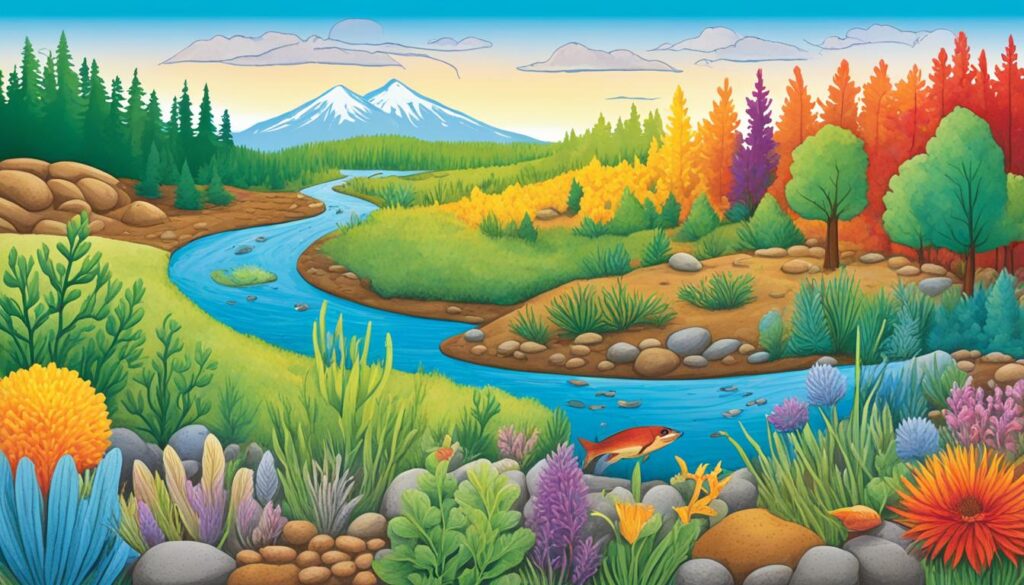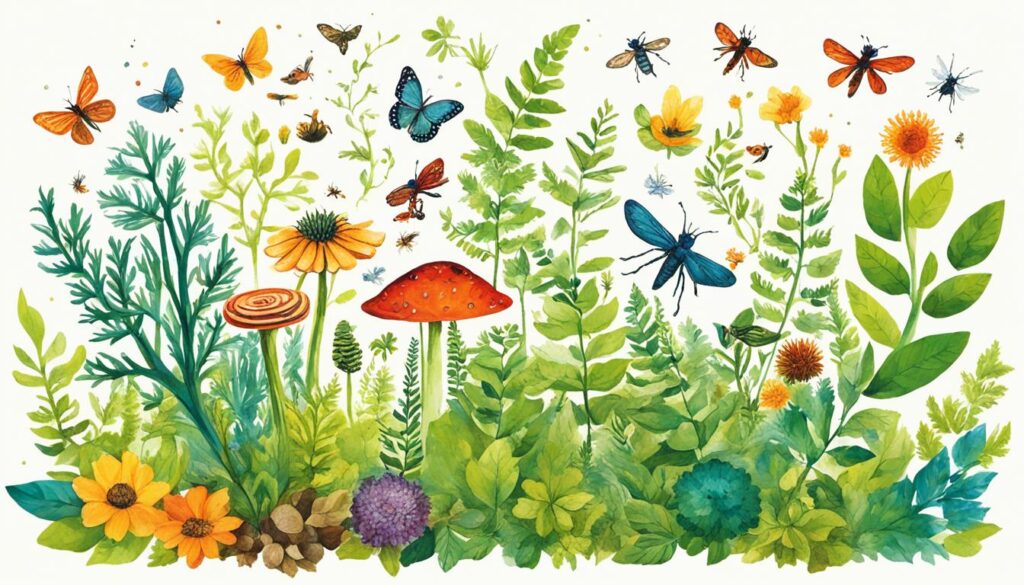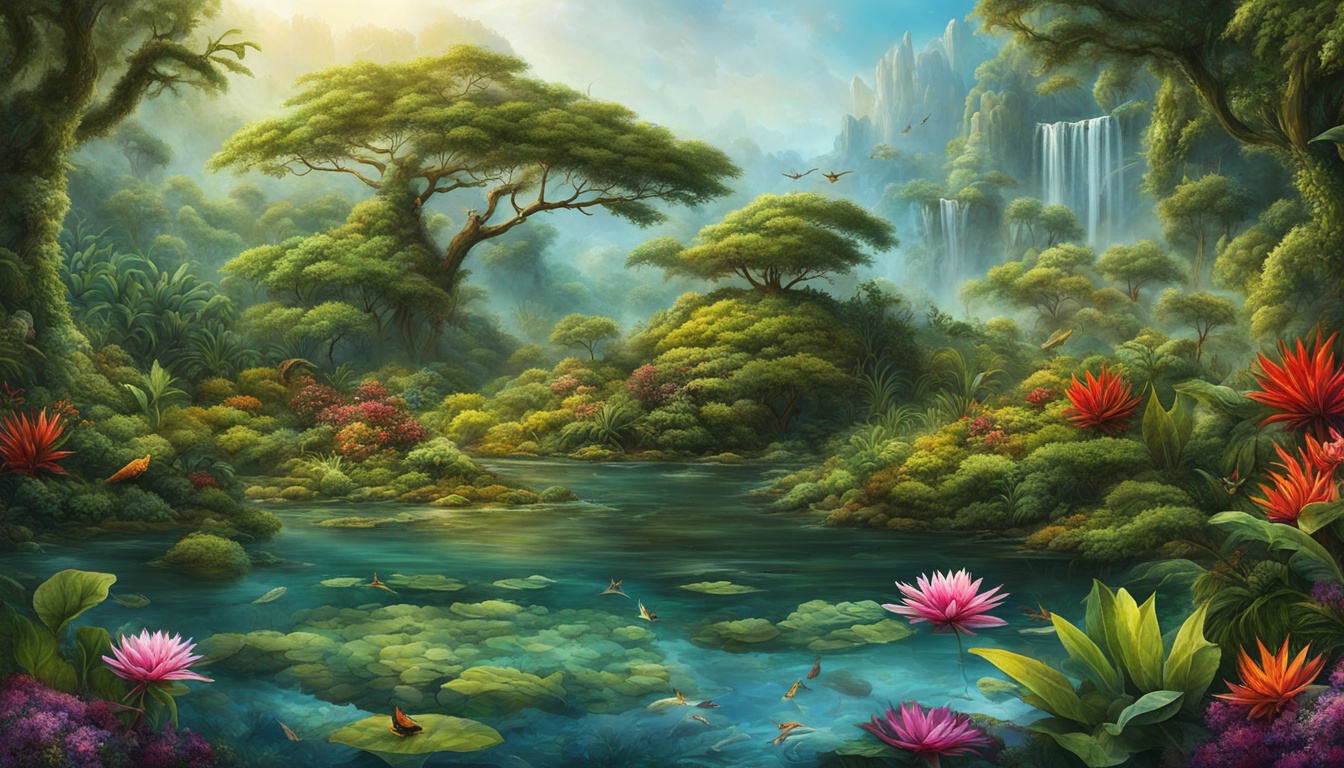In the big picture of our Earth, the close relationship between biodiversity and balance is key. It’s what keeps nature in harmony. Let’s dive into how important biodiversity is for keeping our natural world healthy1.
For centuries, great minds have taught us about the fragile balance of nature. They showed us how everything is linked together, from nature’s economy viewpoint to the vast network of ecosystems. We’ll learn about this special connection that keeps life on Earth thriving2.
Key Takeaways
- Biodiversity is the foundation of ecological balance, sustaining the harmony of nature.
- The intricate web of interconnected ecosystems is crucial for maintaining the delicate equilibrium of our planet.
- Human activities have significantly impacted biodiversity, leading to species extinction and disrupting the natural balance.
- Preserving biodiversity is essential for maintaining the stability and resilience of ecosystems.
- Embracing sustainable practices, such as agroecological approaches like Natural Agriculture, can help restore the balance between humans and nature.
Understanding Biodiversity’s Vital Role
Biodiversity is the wide variety of life on Earth. It is key for keeping our ecosystems in check. It covers species variety, genetic differences, and ecosystem types34. This mix of all living things is stunning and crucial for our planet’s health and our own lives.
Defining Biodiversity and Its Significance
Biodiversity is vital for our planet’s health and strength. It helps provide life-sustaining services like making food, cleaning water, and controlling the climate34. The many species and their ways of living help keep Earth’s systems in harmony. This is crucial for life as we know it.
Ecosystem Services and Biodiversity’s Contributions
How important is biodiversity? Very. More than 60% of people use plants for medicine. And cultures around the world depend on nature for their health and traditions3. Also, most diseases humans get come from animals, showing how closely our health is tied to the environment3. So, looking after the variety of life matters a lot for keeping us healthy and safe.
Biodiversity also fights climate change. Places like forests absorb and keep carbon from the air, helping slow down global warming4. Protecting these areas means using nature to tackle our biggest environmental problems.
The complex life network of biodiversity is breathtaking. It’s not only beautiful but essential for our future. We must work to save and bring back Earth’s rich diversity. This is how we ensure a thriving planet for the coming generations354.
Ecological Balance: The Intricate Web
Understanding ecological balance is key in knowing how nature works. It shows the many ways plants and animals depend on each other. Biodiversity, or the many different life forms, is what keeps this balance6.
In a healthy ecosystem, every living thing has a role to play. Even small creatures, like insects, are essential. They all work together to keep everything in balance7.
But, this balance can be easily disrupted. If we harm the homes of animals or pollute, it affects the whole system. This could lead to major changes in how energy and materials are used in the ecosystem76.
Keeping this balance alive is very important. We must replant trees and sea life to help their homes grow back. Also, we need to protect places with lots of different species. Doing this helps ensure nature can stay in harmony8.
This delicate balance shows how powerful nature is. We must learn how to help, not hurt, it. By working together, we can protect life on Earth76.
| Ecosystem Service | Description |
|---|---|
| Nutrient Cycling | The movement of nutrients, such as carbon, nitrogen, and phosphorus, through the ecosystem, supporting the growth and development of living organisms. |
| Water Purification | The natural filtration and cleaning of water resources by ecosystems, providing clean water for human and animal consumption. |
| Climate Regulation | The ability of ecosystems to influence local and global climate patterns, regulating temperature, precipitation, and other climatic factors. |
| Pollination | The transfer of pollen between plants, facilitated by various species, enabling the reproduction of many plant species and the production of fruits and vegetables. |
“Biodiversity is the foundation of the ecosystems on which we all depend.”
– Kofi Annan, Former Secretary-General of the United Nations
Evolution and the Changing Nature
The world of biodiversity is always changing. It’s shaped by natural selection and how species interact with their environment. According to Darwin, nature’s balance is fragile. Species need to adapt and find their place in the environment to thrive.
Darwinian Perspective on Nature’s Economy
Darwin’s ideas on evolution have deeply impacted how we see the world. He explained how competition and finding a unique role in the ecosystem are crucial. The Darwinian theory says species continually adjust to survive, competing for resources and creating specific niches.9
Adaptation and finding a unique role are vital for a healthy ecosystem. As species change and spread out, they use different resources. This helps reduce clashes and more species can live together10. The balance between how well different species can compete and their specific roles is key to biodiversity.
Adaptation and Niche Dynamics
Understanding ecological niches is key in Darwin’s thought. Every species has its own niche, based on what it needs and offers the ecosystem. This setup lets many different species live together by using diverse resources.10
Adaptation is crucial in this setup. Species change over time to fit their environment better and survive. From tiny microbes to big predators, adaptability is what makes a species strong.11
Over billions of years, life on Earth has grown diverse thanks to adaptation and finding unique roles. This constant change between adapting and fitting into different roles has led to the variety of life we see today.11
Evolution and adaptation show how life on Earth is strong and flexible. Knowing how Darwin’s ideas work helps us keep our planet’s balance. It gives us clues on keeping biodiversity safe despite new challenges.
Equilibrium Theories and Succession
The study of ecological succession is vital in ecology. It shows the changes in natural communities over12 time. Ecological succession explains how new communities replace old ones. This can happen on new land or after a disturbance12.
Henry Chandler Cowles was key in studying ecological succession12. He worked at the University of Chicago. Cowles and others watched the process from sand dunes to oak forests at Indiana Dunes. This area helped them see the process clearly12.
Clements’ Monoclimax Concept
Frederic Clements came up with the “monoclimax” theory. He said every area on Earth can have a stable ecosystem based on its climate12. This mature ecosystem, or climax community, was seen as the best and most stable state12.
But, time has changed this view. Ecologists now know ecosystems are always changing12. Things like resource availability and human activities change these ecosystems. This has led to ideas for better managing and restoring them12.

New ideas, like the Equilibrium Theory of Biodiversity Dynamics, keep coming. They add to our knowledge of how ecosystems work. Understanding this helps with restoration and conservation efforts12. The work of people like Cowles and Clements is crucial in our understanding of nature12.
| Concept | Description |
|---|---|
| Ecological Succession | The process by which natural communities replace one another over time, with primary succession occurring on new or exposed land and secondary succession following a disturbance. |
| Clements’ Monoclimax Theory | The idea that every region on Earth can support a single, stable mature ecosystem stage based on the prevailing climate, with the climax community representing the endpoint of the succession process. |
| Ecosystem Stability | The ability of an ecosystem to maintain its structure and function in the face of disturbances, with equilibrium theories aiming to explain patterns of biodiversity and community abundance. |
The Equilibrium Theory of Biodiversity Dynamics (ETBD) looks at the connections between resources and biodiversity. It includes niche complementarity and facilitation13. ETBD studies biodiversity, focusing on how new species are made. It also looks at the total species in an area13.
ETBD says that biodiversity affects how many species you find in a place. This is the BECA idea13. It suggests that, based on size, species populations have certain chances of changing. Research and theory back this idea14.
The study of ecological succession and theories is always growing. We learn more about the complexity of nature. The knowledge from these theories is very important. It helps us care for and restore nature121314.
Ecosystems, Energy Flow, and Stability
Every ecosystem is a finely tuned system, relying on the constant movement of energy to stay stable and strong15. We learn from the 10% Rule that only 10% of energy moves up to each level in the food chain15. Because of this, food chains are usually short, showing how energy lessens with each level it moves through15.
The flow of energy between different ecosystem levels impacts biodiversity and how populations change15. Just 10% of energy gets passed on at each level, with the rest lost as heat15. This pyramid of energy shows why producers and different types of consumers are key to keeping the ecosystem in balance16.
Sunlight is vital for life, serving as the main energy source for most ecosystems15. It not only powers photosynthesis but also drives processes like oxygen creation and carbon cycles15. This energy moves through the ecosystem, from plants to animals to decomposers, ensuring its health and stability16.
Comprehending how energy flows in ecosystems helps us see the beauty of their balance17. This insight shows us how everything is connected and reliant on each other. It underscores the importance of protecting biodiversity for an ecosystem to keep thriving16.
The intricate web of energy flow and the dynamic interconnections within an ecosystem are essential for maintaining its overall stability and resilience.
“Ecosystems are not just a collection of species; they are complex, dynamic systems where energy and matter flow through intricate pathways, shaping the very fabric of life on our planet.”
Biodiversity and Ecological Balance: A Dynamic Interplay
The amazing link between biodiversity and keeping our environment balanced has been a hot topic for scientists and nature lovers. The theory of island biogeography dives deep into how having lots of different plants and animals affects the balance of nature18.
Island Biogeography and Species Equilibrium
Islands vary in size and isolation, which affects how many different species can live there. Bigger islands mean more room for diverse plants and animals to find their own space. As a result, you get a wide range of life on larger islands18.
On the flip side, smaller islands limit the types of life that can live there. They just can’t offer as many unique homes for various species. This results in fewer different species on these tiny lands18.
The island’s size and how isolated it is influence which species can make it their home. It’s a battle between finding a new place to live and surviving in a place that might not be perfect18. This struggle balances the number of species in any given area18. And it doesn’t just happen on islands; it’s happening in all kinds of ecosystems out in the world18.
Biodiversity is the hero that keeps our ecosystems in check19. With many different species doing their part, they keep everything in order. They make the world work smoothly together. This role of biodiversity doesn’t stand still; it keeps responding to a changing world18.
| Ecosystem Characteristic | Impact on Biodiversity | Significance for Ecological Balance |
|---|---|---|
| Island Size | Larger islands support greater species diversity, while smaller islands have lower species equilibrium. | The size of an island influences the number of ecological niches available, which in turn shapes the overall community structure and ecosystem dynamics. |
| Habitat Fragmentation | Fragmentation can lead to the isolation of populations, reducing genetic diversity and increasing the risk of local extinctions. | Habitat fragmentation disrupts the interconnected nature of ecosystems, compromising their ability to maintain a stable and resilient balance. |
| Invasive Species | Invasive species can outcompete and displace native species, altering the composition and dynamics of the local ecosystem. | The introduction of non-native species can disrupt the delicate balance of an ecosystem, leading to cascading effects on the entire community structure and functioning. |
The link between biodiversity and ecological balance is always changing. Many factors, from small to very big, are at play18. Knowing how these pieces fit together is key to protect and live well with our natural world. We want it to be safe and thriving for the future19.
“Biodiversity acts as a buffer and homeostasis agent contributing to the coevolution of ecosystems and the biosphere.”18
- Biodiversity is key to making ecosystems strong and able to bounce back from troubles19.
- Special species are very important for keeping their ecosystem healthy and working well19.
- We must work hard to save habitats, fix ecosystems, and use natural resources the right way. This helps keep the balance between nature and human life19.
The complex dance of biodiversity and keeping nature’s balance is a sign of how rich and alive our planet is18. We need to understand these complex systems. It’s the only way to truly value the critical role of healthy, diverse ecosystems. They are the lifeblood of our planet181920.
Resilience: Embracing Nature’s Adaptability
In nature’s intricate tapestry, resilience shows how adaptable it is. Ecological resilience is vital for ecosystems to handle disturbances and keep working well. This concept shows how living things and the environment interact dynamically.
Defining Ecological Resilience
Resilient ecosystems can organize and adapt when faced with challenges. Extremophiles are organisms that live in harsh environments. They teach us how nature survives tough times21. Also, partnerships like pollination and mutual help between species prove adaptation’s power in lively environments21.
Biodiversity is key in boosting resilience. A mix of species and how they work together helps ecosystems endure and bounce back from harm21. This is clear in secondary succession, where complex life gradually comes back after events like forest fires21.
Resilience and Ecosystem Management
Knowing and accepting ecological resilience is crucial for managing ecosystems. Plants in deserts, for example, have adapted to harsh conditions by storing water and having deep roots21. And, damaged coral reefs can heal through processes like new coral growth21.
Ecosystem managers can keep these environments healthy by tapping into their natural adaptability22. They can use strategies that promote the ecosystem’s ability to care for itself. Using sustainable methods, like boosting biodiversity, greatly helps the resilience of nature and communities, making them strong in the face of change2223.
“Resilience is not about returning to normal, but about thriving in a new normal.” – Unknown
As our world changes fast, learning from nature’s resilience is key. It can help keep ecosystems healthy for the long term, benefitting the communities around them23.
biodiversity and ecological balance: A Symbiotic Relationship
The link between biodiversity and balancing nature is like a graceful dance. In this dance, every part is crucial for keeping the environment in harmony. The Gaia hypothesis talks about how all living and non-living things on Earth work together. They do this to maintain a condition that allows life to flourish24.
Central to this harmony are the many ways living things and their environment influence each other. There are four main types of interactions: mutualism, commensalism, parasitism, and competition24. The ocean serves as a great example of these interactions due to its high number of diverse species24.
In mutualism, both sides win. For example, clownfish and sea anemones in tropical waters both benefit. In commensalism, one party benefits with no positive or negative effect on the other, such as barnacles on the skin of humpback whales24. Parasitism involves one organism gaining at the expense of another, like nematodes and leeches living in the ocean24.
Competition is also key in the ecosystem. For instance, sponges and corals battle for resources in coral reefs. This competition often shapes the ecosystem’s balance. This shows how all forms of life and the environment interact with each other24.
The balance of these relationships is under threat as over 40% of the Earth’s land faces degradation8. To combat this, the global community plans to protect 30% of our planet’s land and ocean by 2030. Efforts like reforestation, protection of key species, and seaforestation are critical for saving these vital relationships8.
Preserving our planet’s biodiversity means recognizing these delicate ties. As we protect the environment, we support the web of life on Earth248.

Anthropogenic Impacts and Conservation Efforts
Human activities are leaving a big mark on the Earth, harming many species and natural areas. We are cutting down huge areas of rainforests and melting Arctic ice quickly. These changes clearly show how we are influencing our planet25.
Our actions like overfishing, making pollution, and changing the climate are messing with ecosystems everywhere. Atlantic cod numbers have fallen a lot25. And there’s a huge area in the Pacific Ocean where plastic trash gathers, getting bigger all the time25.
Human Activities and Biodiversity Loss
We are turning forests into farmland, particularly for soy, palm oil, and beef. This is wiping out many animals’ homes25. The Red List identifies over 16,000 types of animals and plants at risk – that’s a lot of different species26.
Even our cities are affecting wildlife. In the Netherlands, 18 bird species found in business parks are already endangered26. In London, rooftop surveys uncovered rare insects making their homes there26.
Strategies for Biodiversity Conservation
We have to take action now to save our planet. Restoring and protecting natural areas can help a lot. This includes planting trees again and fixing up wetlands27. It gives threatened animals and plants safe places to live.
Using our resources wisely and being careful about how we fish is also important. So is turning to renewable energy to lessen our impact on nature27. Setting strong rules to help vulnerable species is key too27. If we all work together, we can make sure the Earth stays beautiful and healthy for the future.
“The fate of humanity is inextricably linked to the health of our planet’s ecosystems. By prioritizing biodiversity conservation, we not only protect the natural world but also secure our own well-being and prosperity.”
Conclusion
Looking at nature’s interconnected web, it’s clear we must protect it for our future. This article shows how important it is to keep the balance that supports life28.
Earth holds more than 12 million species, but many are at risk28. This pushes us to do more to save them and learn about our place in nature.
We face many challenges regarding nature, like losing homes and battling climate change29. It’s time to show more respect for our planet. Joining with nature can help save it. And, companies like KAMPOS, working with the One Ocean Foundation28, are leading us to protect our home planet together.
FAQ
What is the definition of biodiversity?
Why is biodiversity important?
What is ecological balance?
How does the Darwinian perspective explain the dynamics of nature’s “economy”?
What is the Clements’ monoclimax theory?
How does energy flow contribute to ecological stability?
What is the relationship between biodiversity and ecological balance according to the theory of island biogeography?
What is the meaning of ecological resilience?
How does the Gaia hypothesis explain the symbiotic relationship between biodiversity and ecological balance?
What are some strategies for biodiversity conservation?
Source Links
- Ecological Balance
- Biodiversity is vital to nature, but what is it? | WWF-Australia | Biodiversity is vital to nature, but what is it? | WWF Australia
- Biodiversity and Health
- What Is Biodiversity?
- Biodiversity Explained: Facts, Myths, and the Race to Protect It
- What keeps our Ecosystem Balanced?
- Balancing Development and Biodiversity: A Delicate Equation – Headway Environmental
- veritree blog | Why is Biodiversity Important to Ecosystems?
- Biodiversity – our strongest natural defense against climate change | United Nations
- The Maintenance of Species Diversity
- The Elements of Biodiversity
- Ecological succession, explained
- The equilibrium theory of biodiversity dynamics: a general framework for scaling species richness and community abundance along environmental gradients
- The equilibrium theory of biodiversity dynamics: a general framework for scaling species richness and community abundance along environmental gradients
- Energy Flow in Ecosystems: Sources, Processes
- Food Webs: Types, Importance, & Examples | Eden Green
- Energy Economics in Ecosystems | Learn Science at Scitable
- Revisiting Biodiversity and Ecosystem Functioning through the Lens of Complex Adaptive Systems
- Ecosystem Dynamics: Biodiversity, Food Chains
- The Dynamic Interplay of Biodiversity in Rainforest Ecosystems – Free Essay Example | PapersOwl.com
- Nature’s Lessons: How Observing the Natural World Can Teach Us About Resilience and Adaptation — An Darach Forest Therapy
- Beyond Concrete: Designing with Nature to Support Biodiversity
- Putting nature and biodiversity loss on the business agenda
- Symbiosis: The Art of Living Together
- Human Impacts on Biodiversity – AP Enviro Study Guide 2024 | Fiveable
- The human impact on biological diversity. How species adapt to urban challenges sheds light on evolution and provides clues about conservation
- Environmental Biology: Studying the Impact of Human Activities on Earth | Park University
- Biodiversity: What it is and Why it is Important to Preserve it
- What is Biodiversity? Why Is It Important? | AMNH

